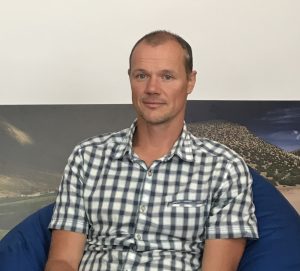It takes guts and lots of effort – countless hours of coding and testing – to come up with a new solution for problems that people encounter on a daily basis. However, if you don’t put your ideas to a stress test, you won’t know whether it works or not. The guys at APPFORTÉ – a team of five people based in Marosvásárhely/Târgu Mureș – do not have an endless budget and work day in and day out. But besides delivering on the projects that bring revenue to the company, the team has ventured into prototyping hardware and writing code, as they strongly believe technology should improve people’s lives. And they do everything within their power to live up to their values.
We sat down with Ákos Bálint, the co-founder of APPFORTÉ. A simple and sportive person, Bálint speaks about their project ideas with passion and enthusiasm, which engages you with such projects because they are serving a good purpose.
A friend of mine was at a routine check up for her children when the doctor drew her attention to something she hadn’t even imagined her children could have: both of them had flat feet. The information she received was shocking to her, but after looking at the bigger picture, it turns out that flat feet are the most common orthopedic issue in pediatrics.

The problem is, if this problem is not addressed in childhood, it can cause serious health problems later. Bálint and his team acknowledged this issue, put their knowledge and existing technology to work, and came up with a solution, which they call HIMO (Health In Motion). “Children love to play video games, and HIMO combines the exercises with video games. We started working together with physiotherapists to develop a treatment program, and technology is a great help here because there is a lack of well-trained professionals – a known phenomenon in every field of health care – and those who are available have limited time. Also, many families don’t have the financial and physical means to visit a therapist as often as required,” Bálint says. The work is ongoing, and they have found a great solution to help children correct the problem and also motivate them to do the exercises by using serious games in the process.
HIMO is a combination of off-the-shelf hardware and in-house developed software. The hardware part of HIMO is a band equipped with eight sensors, as well as a motion detector and gyroscope, which the child places around his or her lower leg. The sensors detect the muscle activity and the movements of the foot. There are four exercises children with flat feet must do: standing tiptoe, short foot, calf stretch, and toe yoga.
“Using the data the sensors receive, we can tell which of the four exercises the child is performing. We have connected the band with a game, so every time the child is standing on tiptoe, the main character of the video game jumps,” Bálint explains. One of the tested concepts is a Super Mario-like figure, a girl, who runs on a trail with obstacles. In order to successfully complete that level, the child must stand on tiptoe every time she or he sees an obstacle or a reward, so the main character completes the task.
“That is a game that is already available on the market. In the early testing phase, we used it to see how our concept worked. We realized that these games are unable to serve our purpose because they are skill-based games and punish the user if they fail to perform the task (for example jump over an obstacle), as the lead character dies. We don’t want that to happen. We want to motivate the child, not foster frustration,” Bálint says. Currently, the APPFORTÉ team is focusing on two things: collecting lots of measurement data and analyzing the precision of the sensors. A professor from Sapientia University, Dr. Dávid Andrei Iclănzan, is helping them in this area. Secondly, they are developing a new game from scratch. “This year we had a very creative summer intern who got involved in this project, so we have progressed a lot. But still we have a lot of work to do before we can say we have a final product.”
The guys at APPFORTÉ do not lack creative and innovative ideas to serve the good of the community. In collaboration with the Sapientia University Marosvásárhely/Târgu Mureș (student Mihály Csaba Keresztúri, lead by Dr. Márton Lőrinc), they have also developed a haptic belt designed for people with visual impairment. “The belt is equipped with eight little motors and is connected to the visually impaired user’s smartphone running a navigation app. The belt serves navigation purposes, as it gently sends haptic feedback to the user instructing him or her which direction to take. The haptic feedback is a must in a noisy environment – for example, on the streets – because the audio signal the navigation app sends to the user is often lost in the noise,” Bálint says. The project is currently on hold, as the hardware is ready, but a lot of programming work is awaiting Bálint’s team to make it a viable product.
Bálint speaks proudly of their app developed in collaboration with the Maros County Museum. Called Museum Transylvania, the iOS and Android app uses augmented reality to show the user the present and the past of selected points of interest. They combined old photographs and virtual reconstructions to deliver an edutainment app packed with location-based content: text, audio guide, picture overlay, and 360-degree panoramas. However, he is more excited about the next chapter of this project: an augmented reality experience of one of the iconic buildings of Marosvásárhely, the secessionist Palace of Culture, built during the time of the city’s legendary mayor, György Bernády.